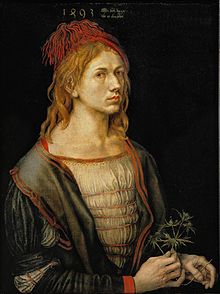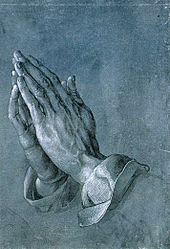Albrecht Dürer
Albrecht Dürer, German: [ˈalbʁɛçt ˈdyːʁɐ]; 21 May 1471 – 6 April 1528) was a German painter, printmaker, mathematician, and theorist from Nuremberg. His high-quality woodcuts (nowadays often called Meisterstiche or "master prints") established his reputation and influence across Europe when he was still in his twenties, and he has been conventionally regarded as the greatest artist of the Northern Renaissance. His vast body of work includes altarpieces, religious works, numerous portraits and self-portraits, and copper engravings. The woodcuts, such as the Apocalypse series (1498), retain a more Gothic flavour than the rest of his work. His well-known engravings include the Knight, Death, and the Devil (1513), Saint Jerome in his Study (1514) and Melencolia I (1514), which has been the subject of extensive analysis and interpretation. His watercolours also mark him as one of the first European landscape artists, while his ambitious woodcuts revolutionized the potential of that medium. Dürer's introduction of classical motifs into Northern art, through his knowledge of Italian artists and German humanists,
has secured his reputation as one of the most important figures of the
Northern Renaissance. This is reinforced by his theoretical treatises,
which involve principles of mathematics, perspective and ideal proportions.
Dürer's introduction of classical motifs into Northern art, through his knowledge of Italian artists and German humanists,
has secured his reputation as one of the most important figures of the
Northern Renaissance. This is reinforced by his theoretical treatises,
which involve principles of mathematics, perspective and ideal proportions.In painting, Dürer had relatively little influence in Italy, where probably only his altarpiece in Venice was seen, and his German successors were less effective in blending German and Italian styles. His intense and self-dramatizing self-portraits have continued to have a strong influence up to the present, especially on painters in the 19th and 20th century who desired a more dramatic portrait style. Dürer has never fallen from critical favour, and there have been significant revivals of interest in his works in Germany in the Dürer Renaissance of about 1570 to 1630, in the early nineteenth century, and in German nationalism from 1870 to 1945.
Dürer's study of human proportions and the use of transformations to a coordinate grid to demonstrate facial variation inspired similar work by D'Arcy Thompson in his book On Growth and Form.
The Lutheran Church remembers Dürer as a great Christian annually on April 6, along with Lucas Cranach the Elder and Hans Burgkmair. The liturgical calendar of the Episcopal Church (USA) remembers him, Cranach and Matthias Grünewald on August 5.
Source:Wikipedia














